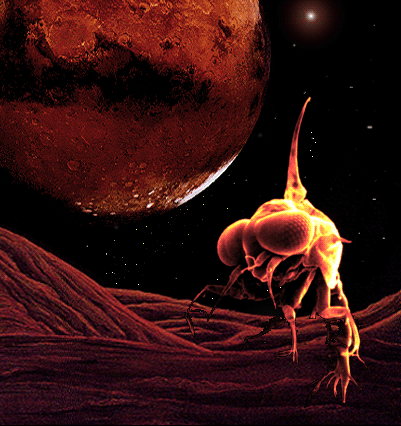variety of extraterrestrial life

Two schools of thought exist on the question of what life (assuming there is any) will be like on other worlds. These fall under the headings of "divergionism" and "convergionism", or to use Harold Blum's terminology, "opportunism" and "determinism". In reality, the truth may well lie somewhere between these extremes. Divergionism stresses the unpredictable and non-repeatable aspects of evolution which generate novelty and therefore might tend to lead to a spectacularly wide range of organisms across the Universe. Convergionism, on the other hand, argues that, while life will inevitably exhibit some differences from one world to another, natural selection will tend to come up with the same optimum designs, reflected in similar biological structures and processes, wherever living things develop. Both these points of view can cite evidence based on observations of life-forms on our own planet.
In favor of divergionism is the astonishing biodiversity found on Earth. Bearing in mind the remarkable differences between, say, hummingbirds and oak trees, or whales and bacteria, all of which have a common heritage, it is difficult to set limits on what richness of forms might occur among extraterrestrial species. Even a replay of terrestrial evolution would almost certainly lead to substantially different end-products, a claim first put forcibly by Wallace and echoed many times since. Conceivably, for instance, an evolutionary rerun would fail to give rise to the land vertebrates at all. And even if it did, the probability of a repeat of the cataclysm which ended the dinosaur dynasty and, as a consequence, allowed higher forms of mammalian life, including ourselves, to fill the vacated niches, would be low indeed at that same pivotal point in Earth's history. This incident alone is enough to suggest that random cosmic events, especially asteroidal or cometary collisions, can have profound and totally unpredictable effects on the course of a planet's biological development (see cosmic collisions, biological effects).
Given the serendipitous nature of mutations and major external influences, divergionists would argue that even if life is constrained to having essentially just one biochemical basis, evolution, in its blind exploration of all biological options, will generate across the vastness of space and time every conceivable, viable type of organism. Still greater diversity could be anticipated if life can arise from a variety of different molecular building blocks. An important factor in this is where the first few chemical steps leading to life tend to take place. If prebiotic synthesis happens almost exclusively on the surface of suitable worlds then it is more likely that wide, homegrown variations in biochemical development occur, than if the organic starter kit arrives from the communal resource of space. That at least some prebiotic chemicals are seeded on infant worlds by asteroid and comet impacts now seems very likely, suggesting that certain fundamental sub-units of life such as amino acids, which have been found in interstellar clouds, may be common biological currency. Yet at what stage up the ladder of prebiotic synthesis major variations between worlds become apparent is not clear. Some biologists believe that wherever life occurs it will use at least some of the same molecules, like sugars, and therefore have some similar biosynthetic pathways, such as the citric acid cycle used to burn sugar and yield energy. Certainly, on an extrasolar planet, the chance of anything like the same gene combinations emerging that underpin contemporary terrestrial life must be vanishingly small. But whether genes themselves, DNA, and proteins lie routinely at the heart of life throughout the Galaxy has yet to be established. The greater the possible biochemical diversity of organisms, the more scope for divergionism to envisage novel forms of cosmic life, including perhaps creatures so different from anything we know that we might not recognize them as being alive. Our very definitions of life might need to be reexamined (see life, nature of).
Convergionism, on the other hand, while acknowledging that chance and circumstances play a part in shaping how life evolves, places greater emphasis on the fact that natural selection is subject to universal laws. Therefore the same motifs will tend to recur, in subtly different guises, as evolution keeps discovering the same best solutions to survival in different environments on different worlds. At the level of gross anatomy, for example, it would be surprising if certain features, such as legs, wings, fins, eyes, and ears, or their near-equivalents, did not evolve independently in many different locations in space. The phenomenon of convergent evolution on Earth suggests that this is true. On the other hand, there is the danger of anthropomorphism and we need to consider carefully the bold attempts by both scientists and science fiction writers, over the past century, to explore the outer limits of what life elsewhere might be like. H. G. Wells offered an early vision of something disturbingly alien with his Martians and selenites, while his Victorian contemporary, Arthur Conan Doyle raised the prospect of a single planet-wide organism in "The Day the Earth Screamed" – a concept given some scientific credibility by the Gaia Hypothesis. Wildly unanthropomorphic aliens go back at least as far as the Lensmen novels of E. E. "Doc" Smith in the 1930s and Olaf Stapledon's Starmaker of 1934, and earlier if one includes the now-neglected late 19th century writings of J. H. Rosny. Biologists have mused on whether life could have an entirely different chemical basis - silicon, perhaps, instead of carbon (see silicon-based life), or ammonia in place of water (see ammonia-based life). Some scientists have speculated further. Fred Hoyle described an intelligent nebula in The Black Cloud, while Frank Drake, an early pioneer of SETI, wondered if life might evolve on a neutron star (see neutron star, life on), an idea taken further and cast into fictional form by the aerospace engineer, Robert Forward.

